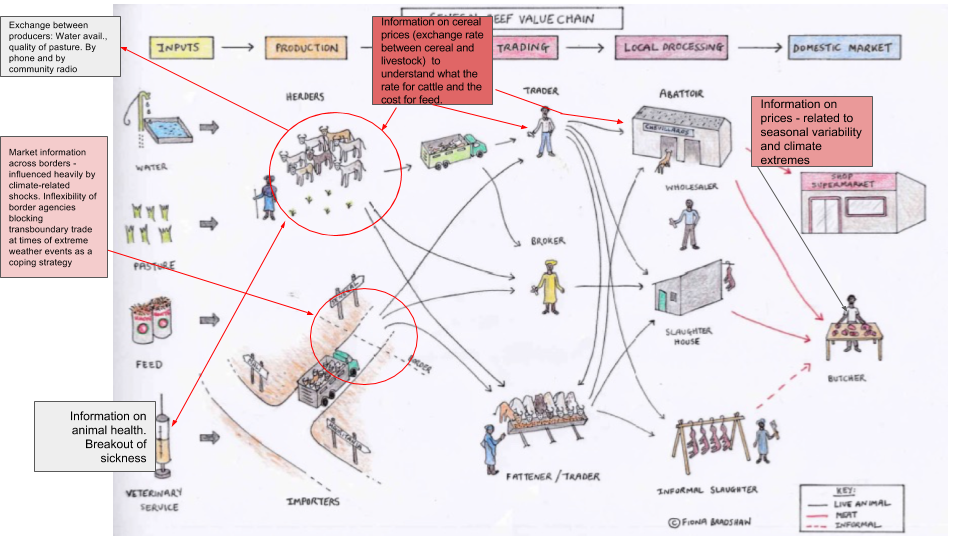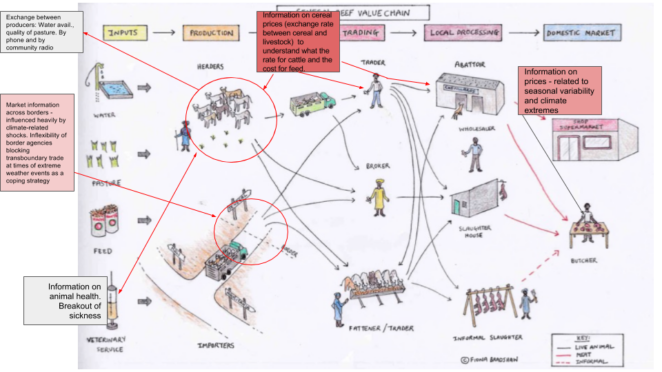Module: Knowledge Systems Analysis for Climate Knowledge Brokers

Introduction
This module offers an introduction to a methodology developed by CKB to allow for more focused knowledge brokering interventions in knowledge systems connected to climate-sensitive value chains. Knowledge Systems Analysis identifies the different actors within a system, the climate knowledge they offer and the climate knowledge they need, and the ways in which they exchange this knowledge with other actors. We have found that looking at the system as a whole rather than starting from the viewpoint of one particular actor provides new insights into the reasons why some end users are not receiving crucial climate information. When the ‘hot spots’ or bottlenecks have been identified, targeted interventions can be designed to improve the flow of information and to ensure that relevant climate information is available to end users at the right time and in a usable format.
The video offers an introduction to Knowledge Systems Analysis based on a fictional case study of a farmer in Uganda, and the information she needs to make decisions on her farm. Below the video you can find an actual case study from one of the pilots carried out to test the methodology.
The video
Case study: The Livestock Value Chain in Kenya
This pilot study covered beef value chains in the southern rangelands of Kenya.
The value chain, including actors, products and connections, was mapped in collaboration with an experienced researcher. Then, a ‘knowledge layer’ was overlaid, showing the knowledge each actor needs to make decisions that could improve her resilience, and where that knowledge should be coming from. Information gaps were identified where the knowledge was not provided by anyone, or the knowledge producers and users were not connected. Information gaps with a significant impact on the overall climate resilience of the system and which were not currently addressed by the actors in the system were classified as hot spots. See the image below for an example – the grey boxes show crucial information that is already being transmitted successfully, whereas the red boxes show crucial information that is not currently reaching those who need it.

Below are two examples of hot spots identified, with their relevant actors and proposed actions:
Knowledge brokering hot spot identified:
Early warning information on extreme weather events is not always accessible to producers.
- This information influences producer decisions on whether to take livestock to market and what is an acceptable price for their livestock.
- The downstream relevance on this is on the quality of product that makes it to market, as effective use of the information would mean that livestock is sold before it starts dying.
- This information is especially relevant twice per year when producers made decisions around de-stocking.
Relevant actors:
- Producers: end users of extreme weather information for decision making.
- National Drought Management Authority (NDMA): Providers of climate information – largely generated for FEWSNET. NDMA publishes monthly bulletins that communicate the current drought status (Normal, Alert, Alarm, Emergency, Recovery) and early warning information. The county offices communicate the EW information via community meetings, partners and a flag-based system (red, amber, green). So the information is technically available (although many communities are remote) but it is more a matter of trust / interpretation of how to respond to a red flag.
Proposed actions:
- Alert system for early warning information; for example, via SMS alerts. This would allow for widely accessible and affordable mass messaging tailored to subscriber language/needs.
Knowledge brokering hot spot identified:
Information on foreign exchange rates being offered for local trading (particularly between Kenyan and Tanzanian shillings) is not accessible to Tanzanian pastoralists.
- These rates are set by middle-men and significantly disadvantage migrant pastoralists from Tanzania.
- Knowledge of these rates (which are influenced by extreme weather and slow-onset events in sending regions) is generally unavailable to Tanzanian pastoralists, leaving them unable to make informed decisions before leaving their country.
- This information is particularly important once or twice per year when extreme weather events (such as droughts) are likely to occur.
Relevant actors:
- Tanzanian pastoralist producers – potential users of the information for decision-making.
- Middle-men who set the exchange rates based not only on official rates but on weather and other factors.
Proposed actions:
- This is not a clear knowledge exchange intervention due to the fact that the information is being deliberately withheld/ distorted.
- A solution could be to provide formal foreign exchange rates to compare with what rates are on offer and aid with bartering.
- We would need to confirm whether or not this information is currently available to producers on market days.
(0) Comments
There is no content